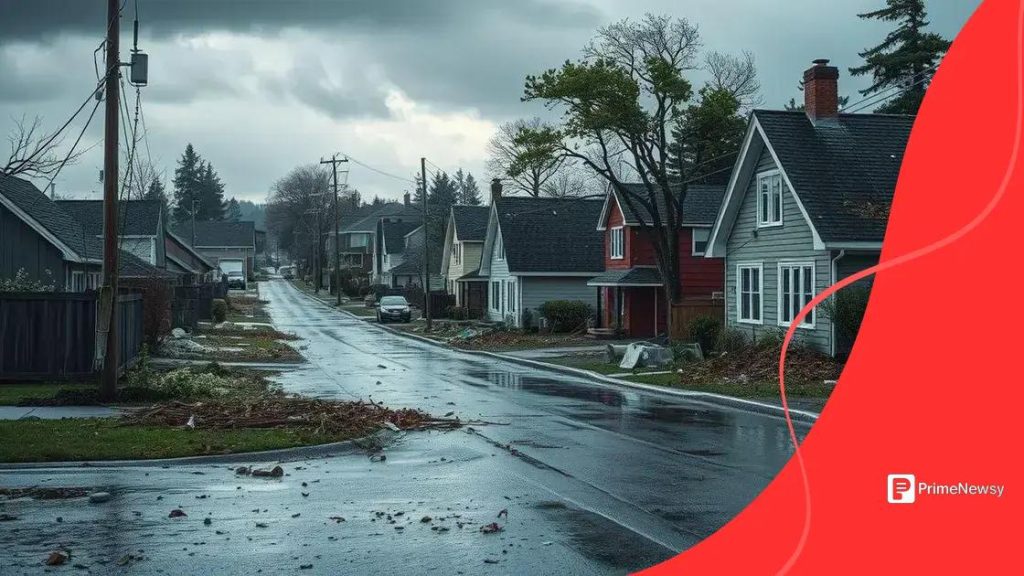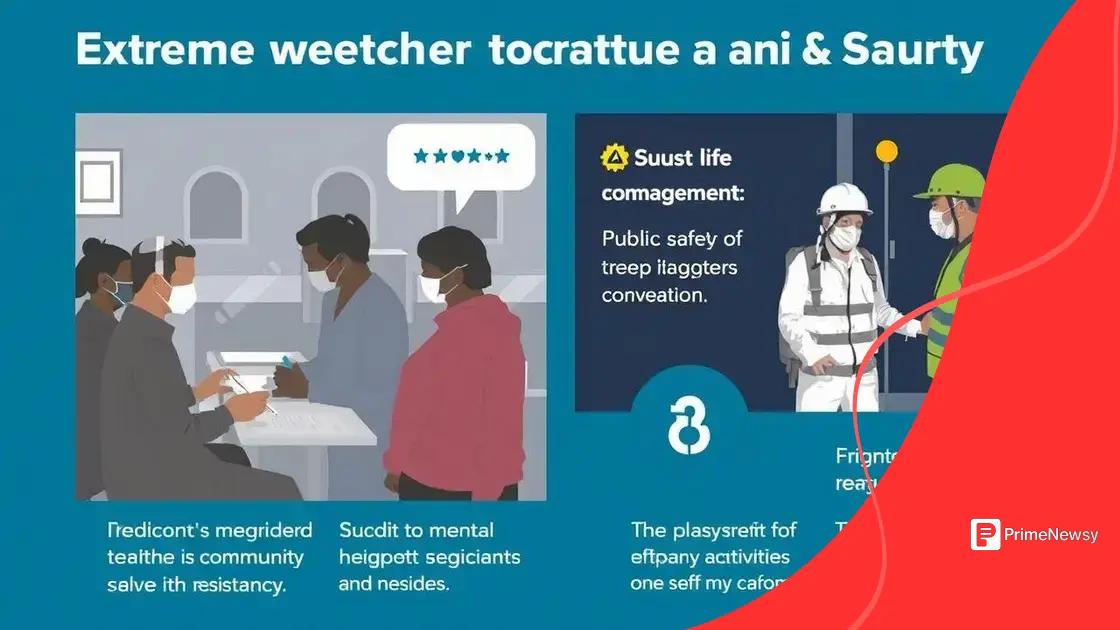Extreme weather events impact communities and economies

Anúncios
Preparing for extreme weather events involves creating emergency plans, engaging communities, investing in resilient infrastructure, and understanding climate change impacts to enhance safety and reduce risks effectively.
Extreme weather events impact us all, often bringing unexpected challenges. Have you ever considered how a storm can change a community’s landscape overnight? Let’s dive into these phenomena and their effects.
Anúncios
Understanding extreme weather events
Understanding extreme weather events is crucial for both planning and safety. These occurrences, such as hurricanes, floods, and heatwaves, affect our daily lives and the environment. They can disrupt communities and cause economic hardship.
Types of Extreme Weather Events
There are various types of extreme weather events that we need to be aware of. Each has unique characteristics and impacts. Some common types include:
- Hurricanes: These are powerful storms known for their intense winds and heavy rainfall.
- Floods: Often caused by heavy rain, floods can damage homes and infrastructure.
- Heatwaves: Extended periods of excessive heat can lead to health risks, particularly for vulnerable populations.
These events are becoming more frequent and severe due to climate change. The science behind these phenomena helps us understand why they occur and how to prepare for them. For instance, meteorologists study weather patterns and atmospheric conditions to predict storms. This knowledge is vital for issuing warnings and minimizing harm.
Anúncios
Another important aspect is the impact of extreme weather on our resources. Agriculture, water supply, and energy are all affected during such events. Crop failures due to hurricanes or droughts can threaten food security. Furthermore, floods can contaminate drinking water, leading to health risks.
The Role of Preparedness
Being prepared is essential when facing these unpredictable situations. Communities can take several steps to enhance their resilience:
- Developing emergency plans for families and localities.
- Creating early warning systems to alert residents.
- Investing in infrastructure that can withstand extreme weather.
Understanding extreme weather events allows us to confront them better. By staying informed and prepared, we can mitigate their impacts and ensure safety for ourselves and our communities.
The economic consequences of extreme weather
The economic consequences of extreme weather are profound and far-reaching. When disasters strike, they disrupt not only daily life but also the economy on multiple levels. Businesses can face significant setbacks, leading to loss of income and even closures.
Direct Costs of Extreme Weather
One immediate impact is the damage to property and infrastructure. Buildings, roads, and utilities can suffer extensive harm. This leads to:
- Repair Costs: Repairing or replacing damaged infrastructure requires significant investment.
- Insurance Claims: High volumes of claims can strain insurance companies and increase premiums for everyone.
- Loss of Productivity: Businesses may need to halt operations, resulting in lost income.
These costs can quickly add up, affecting local economies and creating financial burdens for governments and taxpayers.
Moreover, extreme weather can disrupt supply chains. For instance, floods can halt transportation, delaying goods from reaching stores. This affects not only local businesses but also consumers who depend on those products. In agricultural areas, droughts can diminish crop yield, resulting in food shortages and higher prices.
Long-Term Economic Impacts
The long-term effects of extreme weather events can reshape entire economies. Areas prone to disasters may see a decrease in property values. Additionally, population migration can occur as people move to safer regions, impacting labor markets.
- Job Losses: If industries struggle, layoffs may follow, leading to increased unemployment rates.
- Investment Decrease: Investors may shy away from areas with high disaster risk, limiting economic growth.
- Increased Costs: Governments may need to allocate more resources to recovery efforts, diverting funds from essential services.
Understanding the economic consequences of extreme weather is essential for planning and recovery. By preparing and investing in resilient infrastructure, communities can mitigate some of these impacts, ensuring a more stable future.
Effects on community health and safety

Extreme weather events have significant effects on community health and safety. These events can lead to immediate dangers like injury and death, but the long-term impacts are equally serious. Understanding these effects is vital for planning and response.
Immediate Health Risks
The first concern during an extreme weather event is the safety of individuals. Whether it’s a hurricane, flood, or heatwave, people face immediate health risks:
- Injuries: High winds and flying debris can cause severe injuries during storms.
- Waterborne Diseases: Flooding can spread contaminants, leading to outbreaks of illness.
- Heat-related Illnesses: Prolonged exposure to high temperatures can result in heat exhaustion or heatstroke.
These health risks highlight the importance of preparedness and having a plan in place. Communities often need to work together to ensure safety during such crises.
Moreover, the impact on mental health cannot be ignored. Following extreme weather events, many individuals experience anxiety, depression, and post-traumatic stress disorder (PTSD). The destruction of homes and displacement can lead to feelings of helplessness and fear. Support services are essential to assist those affected.
Long-term Health Consequences
Beyond immediate impacts, communities may face long-term health consequences. Poor air and water quality can develop after a disaster, leading to chronic health problems. Additionally, communities that struggle to recover can experience worsening health disparities.
- Access to Healthcare: Damage to facilities can limit access to medical care, worsening health outcomes.
- Increased Stress Levels: Ongoing economic and environmental stressors can contribute to chronic conditions.
- Substance Abuse: In some cases, individuals may turn to substances as a coping mechanism, creating further health issues.
Addressing the effects of extreme weather on community health and safety requires a comprehensive approach. Community resilience planning is key, which includes preparing emergency services and providing mental health support to those affected. By prioritizing health and safety, communities can better withstand the challenges posed by these events.
How climate change is altering patterns
Climate change is significantly altering patterns of extreme weather events. As global temperatures rise, we are seeing shifts in rainfall, temperature extremes, and storm frequency. Understanding these changes is crucial for preparedness and response.
Changing Weather Patterns
One of the most noticeable effects of climate change is the alteration of traditional weather patterns. Regions that once experienced moderate weather may now face harsher conditions. For instance:
- Increased Rainfall: Some areas are seeing heavier and more frequent rainfall, leading to flooding.
- Drier Conditions: Other regions are experiencing droughts, reducing water supply and affecting agriculture.
- Storm Intensity: Hurricanes and typhoons are becoming stronger due to warmer ocean waters.
These changes can have drastic impacts on people’s lives and the environment. Higher amounts of rain can lead to flash floods, while droughts can cause food shortages.
In addition to rainfall, temperature extremes are becoming more common. Greater frequency of heatwaves poses health risks, particularly for vulnerable populations. As the Earth continues to warm, we can expect these patterns to further evolve.
The Impact on Ecosystems
Climate change affects not only human systems but also natural ecosystems. Shifts in weather patterns can disrupt habitats, resulting in the relocation or decline of certain species. For example, warming oceans can lead to coral bleaching, which harms marine life. Forests may also struggle to adapt to changing moisture levels, increasing the risk of wildfires.
- Species Migration: Animals and plants may move to find more suitable conditions.
- Altered Growing Seasons: Changes in temperature can affect crop yields, impacting food supply.
- Increased Pests and Diseases: Warmer conditions may allow harmful pests to thrive, affecting crops and human health.
Understanding how climate change is altering weather patterns is essential. By recognizing these shifts, communities can better prepare for and adapt to the challenges posed by extreme weather events. Proactive measures can help minimize the impacts on both people and the environment.
Preparing for future extreme weather events
Preparing for future extreme weather events is essential for communities to ensure safety and resilience. As climate change continues to influence weather patterns, taking proactive measures can help mitigate risks and protect lives.
Creating Emergency Plans
Having a well-thought-out emergency plan is the first step in preparation. Communities should develop plans that include:
- Communication Strategies: Establishing clear ways to share information during disasters can save lives.
- Evacuation Routes: Knowing how to evacuate quickly and safely is vital. Maps should be shared with residents.
- Emergency Supplies: Communities should have access to supplies such as food, water, and medical kits in case of emergencies.
These plans should be regularly reviewed and practiced through drills to ensure everyone knows their role during an extreme weather event.
In addition to emergency plans, investing in resilient infrastructure is crucial. Upgrading roads, bridges, and buildings to withstand severe weather can reduce damage and recovery costs. Utilizing materials and designs that can endure floods, high winds, and other extreme conditions is essential in preparation efforts.
Community Engagement and Education
Engaging the community is another key aspect of preparation. Residents should be informed about potential risks based on their region. Educating them about personal and family preparedness can lead to safer outcomes. Programs can be developed to:
- Host Workshops: These can teach residents how to create individual emergency plans.
- Share Resources: Information on where to find assistance during disasters should be made available.
- Encourage Neighborhood Networking: Building connections within communities strengthens support during emergencies.
Preparation for extreme weather events also involves understanding and addressing vulnerable populations. Special attention should be given to those who may require additional support, such as the elderly, disabled, or low-income families. Tailoring emergency plans to meet their needs can ensure their safety during a disaster.
FAQ – Frequently Asked Questions about Preparing for Extreme Weather Events
Why is preparing for extreme weather events important?
Preparing helps protect lives, ensures safety, and reduces damage to property and infrastructure during disasters.
What should be included in an emergency plan?
An emergency plan should include communication strategies, evacuation routes, and emergency supplies to ensure everyone knows what to do.
How can communities engage residents in preparedness efforts?
Communities can host workshops, share resources, and encourage neighborhood networking to raise awareness and preparedness.
What role does infrastructure play in extreme weather preparedness?
Resilient infrastructure helps minimize damage during extreme weather and supports quicker recovery after disasters.